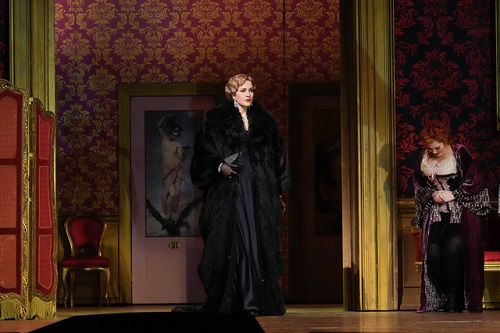 United States Strauss, Der Rosenkavalier: Soloists, Metropolitan Opera Chorus & Orchestra / Simone Young (conductor). Metropolitan Opera, New York, 31.3.2023. (RP)
United States Strauss, Der Rosenkavalier: Soloists, Metropolitan Opera Chorus & Orchestra / Simone Young (conductor). Metropolitan Opera, New York, 31.3.2023. (RP)

Production:
Production – Robert Carsen
Sets – Paul Steinberg
Costumes – Brigitte Reiffenstuel
Lighting – Robert Carsen and Peter Van Praet
Choreographer – Philippe Giraudeau
Cast:
Marschallin – Lise Davidsen
Octavian – Samantha Hankey
Sophie – Erin Morley
Baron Ochs – Günther Groissböck
Annina – Katharine Goeldner
Valzacchi – Thomas Ebenstein
Italian Singer – René Barbera
Faninal – Brian Mulligan
Peter Gelb, the Metropolitan Opera’s general manager, does not shy away from a high-stakes gamble. The latest is Lise Davidsen’s role debut as the Marschallin in Der Rosenkavalier.
There was also a certain amount of risk involved for the prodigiously gifted Norwegian soprano. Not only is the role associated with some of the most fabled sopranos of the past century, it requires so much more than voice, the latter of which Davidsen has in abundance. Fortunately for all involved, especially those able to experience Davidsen’s first appearances as the Marschallin, the gamble paid off.
At 36, Davidsen is just a few years older than the fictional Marschallin. It is no injustice to state that her characterization is a work in progress, but her voice was resplendent and the acting nuanced. At this performance, she was the most sensitive of artists, scaling her voice to not only fit the role but also to blend effectively with her colleagues on stage. Youth is a trump card that Davidsen, like the Marschallin, can’t play forever, but it is a singular experience to enjoy a singer so talented and adventuresome in such a wide array of roles at this stage of her career.
Davidsen’s youth made it all the more bittersweet that the most moving moment of performance was when the Marschallin tells her hairdresser that he has made her look like an old woman. Her Marschallin was instantly transformed from a carefree young woman into a statue. The inevitable passing of time and the resultant fading of her physical charms would mean the end of her dalliances with younger men, of whom Octavian was her current conquest.
Samantha Hankey had all the cockiness and gait of seventeen-year-old young man reveling in his sexual prowess and the affections of an alluring older woman, and puffed a post-coital cigarette with the best of them. Her characterization was made all the richer musically by her sizable, sinewy mezzo-soprano. As ‘Mariandel’, she combined bashfulness and awkwardness with a wicked sense of humor to bewitch and befuddle Günther Groissböck’s coarse, virile and dangerous Baron Ochs.

Groissböck performed with his accustomed style and gusto. Despite the brilliant comic strokes that he brings to the role, his Ochs is as sexually potent as he is dangerous. Groissböck doesn’t have the most cavernous low notes in the business, but his Ochs is a force to be reckoned with and will define the role for a generation of opera goers.
Erin Morley as Sophie was a vision in white with shimmering high notes and a lot of pluck. It was heartbreaking to watch her bewilderment as she realizes her rival in love is the Marschallin. She expressed relief and amazement that Octavian loved her with a bloom of joy in both her face and voice.
There were fine performances in the many supporting roles. As the Italian Singer, René Barbera appeared all in white and pulled off a decent Caruso imitation, even signing one of his records for the Marschallin. Katharine Goeldner and Thomas Ebenstein were a winning combination of schemers who aided and abetted Baron Ochs’s comeuppance. And Brian Mulligan was a particularly robust, if beleaguered and befuddled, Faninal.
However, Robert Carsen’s production, first seen at the Met in 2017, is a cumbersome affair and already dated. Set in Vienna in 1911, the year of the opera’s premiere, Carsen clumsily introduces the specter of war into the staging. It made some sense when the production premiered as the 100th-anniversary commemorations of World War I were constantly in the news, but time has marched on and, from the comments overheard, the connection was lost to most in the audience.
The stage is also cluttered with far too many people. Carsen keeps it under control in Act I where the Marschallin is besieged with petitioners at her morning levée, but things start to veer out of control at the end of Act II when Och’s soldiers run amok and terrorize Faninal’s staff. It is rather tame compared to what Carsen serves up in the final act: the inn where Baron Ochs has a rendezvous with Mariandel must be the busiest brothel in Vienna, complete with a cross-dressing madam.
But the music was served splendidly. Simone Young led the Met orchestra in a performance in which the waltzes were lighter than air, and the marches in three-quarter time that course through the opera were crisp and energetic. Young’s attention to balance was exceptional, especially in forging a cohesive whole out of voices of such different weights and colors as those of Davidsen, Hankey and Morley.
In the final scene, the appearance of Davidsen’s stunningly beautiful Marschallin, exquisitely attired in black, cast a spell over the performance both physically and vocally. The soaring phrases of the Marschallin that begin the final trio, ‘Hab mir’s gelobt’, were effortless if not quite ethereal, but the emotion in Davidsen’s voice was real. Young led a stunning performance of Richard Strauss’s sublime music which was as engrossing as it was enchanting.
Rick Perdian